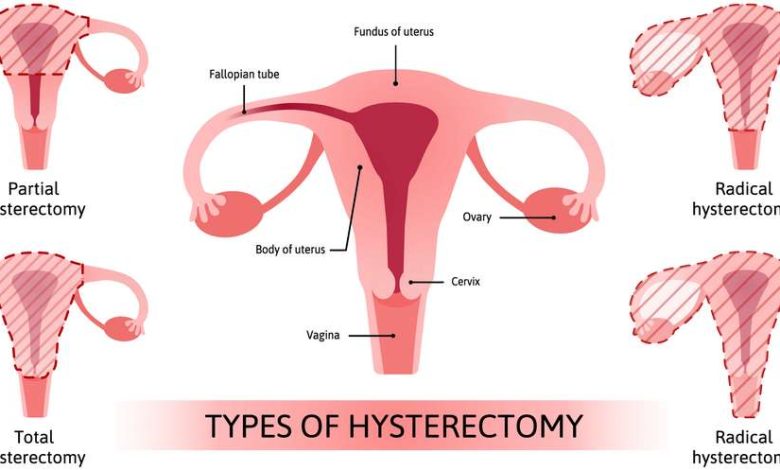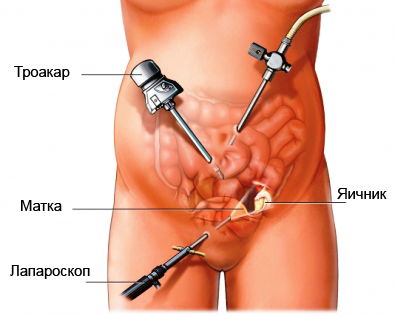Laparoscopic Hysterectomy, hysterectomies: what is this operation, causes, Contraindications, how they do it, what after

Description hysterectomy
Hysterectomy is a surgical term, means an operation to remove the uterus. After this operation, a woman is unable to conceive. The operation is performed through the abdominal cavity or vagina..
There are several types of hysterectomy:
- Partial or subtotal hysterectomy - removal of the uterus (without removing the cervix);
- Shared, total, or simple hysterectomy - removal of the uterus and cervix (ovetmlenie uterus, enough to produce the vagina);
- Radical hysterectomy - removal of the uterus, ovary, the fallopian tubes, the upper part of the vagina, and the pelvic lymph nodes;
- Salpingo-oophorectomy, removal of the ovaries and fallopian tubes (It can be combined with any of the above procedures).
Reasons for Hysterectomy
Holding a hysterectomy may be performed if uterine disease cannot be cured in other ways. Hysterectomy is performed in cases:
- Cancer Treatment (eg, uterus, endometrial cancer, ovarian cancer);
- Removal of uterine fibroids – noncancerous tumors, growing in the muscle of the uterus;
- The treatment of chronic pelvic pain;
- For the treatment of severe bleeding.
Before the decision to hold a hysterectomy try to solve the problem by other means. There are effective treatments for many of the above problems.
Possible complications of hysterectomy
Complications of hysterectomy include:
- Adverse reaction to anesthesia;
- Pain;
- Infection;
- Bleeding;
- Fatigue;
- Injury to the pelvic organs (bowel and / or bladder);
- Urinary incontinence;
- Loss of ovarian function and early menopause;
- Depression;
- Sexual dysfunction.
Factors,increase the risk of complications:
- Obesity;
- Smoking;
- Diseases of the heart and lungs;
- Diabetes;
- Previous surgery in the pelvic or severe infection;
- Use of certain drugs during the last month before the operation.
How to conduct a hysterectomy?
Before surgery
Before the surgery, do the following survey:
- Blood and urine tests;
- Mazok Papanicolaou;
- X-ray examination of the abdomen and kidney;
- Pelvic ultrasound;
- Surgical removal of tissue, closing the uterus;
- It is necessary to put an enema, to clean out the bowel.
You should do the following:
You may need to stop taking certain drugs for one week before the procedure:
- Do not take anti-inflammatory drugs (eg, aspirin);
- Do not take blood thinners, as clopidogrel (Plaviks) or warfarin;
- If ordered, you need to take antibiotics
You can not eat on the day of surgery.
Anesthesia
The procedure is performed under general anesthesia.

Hysterectomy Procedure
The doctor makes a small incision near the navel, to insert a laparoscope (tool with a camera on the end). This device allows the doctor to see the pelvic organs. To better examine bodies, the abdominal cavity is filled with carbon dioxide. The doctor also makes a few small incisions in the abdomen. Through these incisions are other surgical instruments are inserted. The incision is made at the site of, where the uterus joins the vagina. The bladder and rectum are separated from the uterus. The uterus is removed through the incision of the vagina. After that, the doctor sews the incisions.
In some cases, it may require open surgery.
Immediately after the procedure, a dropper is placed and the necessary medications are taken..
How long does a hysterectomy?
The operation lasts about 1 to 3 hours.
Will it hurt?
There is a possibility of pain, vzdutiya life, vaginal bleeding or spotting for days after the operation. In this case it is necessary to take painkillers.
Time of hospital stay
Extract from the hospital carried out the same, or the next day after surgery. Most of the time due to the presence of complications posleopertsionnyh.
Nursing care after surgery
In the hospital
While in the hospital, you can get the following help:
- The first nurse will help you sit up and walk;
- The next morning after the operation the dropper is removed, if you start to eat;
- Maybe, you have to wear special socks or shoes, to prevent blood clots;
Houses
You must perform the following procedures:
- Follow your doctor's instructions;
- Properly care for cuts. This will help prevent infection.
- Some time is necessary to refrain from taking a shower, baths, or contact with water cuts;
- During the first two weeks not to lift heavy objects;
- Gradually increase the intensity of the movements. Start with light housework, short walks;
- To accelerate the healing of cuts, Eat plenty of fruits and vegetables.
Try to avoid constipation:
- Do not eat foods that are high in fiber;
- Drink plenty of water;
- If necessary, take laxatives.
Ask the doctor, when you can use tampons. Do as Kegel exercises;
Podozhdite six weeks, before resuming sexual activity;
If the cervix is not removed, you must make regular Pap tests.
You should immediately go to the hospital in cases:
- Appearances fever or chills;
- Redness, edema, pain, bleeding or discharge from the incision;
- Gapping;
- Nausea and / or vomiting;
- Dizziness or fainting;
- Cough, breathlessness, chest pain;
- Heavy bleeding;
- Pain, It does not stop even after taking pain;
- Pain, burning, frequent urination or presence of blood in urine;
- Edema, redness or pain in the legs.
